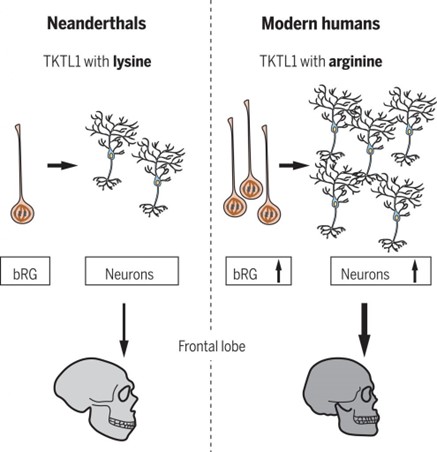Fossilized skulls and skeletons clearly show the physical similarities and differences between modern humans, and our ancestors, the Neanderthals.
However, insights into a Neanderthal brain, and its intellectual capacity, have evaded researchers since soft tissue isn’t easily preserved over thousands of years.
Our skulls are remarkably similar in size to a Neanderthal skull, which does not suggest any difference in neurons or brain function.
A fascinating new study unlocks the key to our brain development and cognitive advantage, helping explain why the Neanderthals went extinct about 40,000 years ago.
Researchers at the Max Planck Institute of Molecular Cell Biology and Genetics (MPI-CBG) in Dresden discovered that a genetic mutation, known as the TKTL1 protein, is responsible for our advanced abilities.
They found a single amino acid change in the transketolase-like-1 (TKTL1) protein, which is linked to neuron production. TKTL1 is one of the few proteins with a single amino acid substitution found in almost all humans alive today but non-existent in the Neanderthals.
The TKTL1 protein increases one type of brain progenitor cell called the basal radial glia. These cells generate the majority of neurons in the developing neocortex – leading to a higher number of neurons. This likely gave modern humans a cognitive edge, regardless of overall brain size.
“We found that with the Neanderthal-type of amino acid in TKTL1, fewer basal radial glial cells were produced than with the modern human-type and, as a consequence, also fewer neurons, says Anneline Pinson, lead author of the study.
“This shows us that even though we do not know how many neurons the Neanderthal brain had, we can assume that modern humans have more neurons in the frontal lobe of the brain, where TKTL1 activity is highest, than Neanderthals.”

Figure 1 – TKTL1 and human cortical neurogenesis. A single amino acid substitution in modern humans leads to greater bRG levels than that seen in Neanderthals. This, in turn, leads to more neocortical neurons.
Lauren Robertson, Science Writer
Image credit: https://frontlinegenomics.com/single-gene-mutation-explains-increased-cognitive-abilities-of-modern-humans/
Because this new mutation of the TKTL1 protein was so advantageous, it became an established part of the modern human brain.
This fundamental difference in our evolution helps explain our intelligence and the origin of major diseases such as cancer, cardiovascular disease, and dementia.
The TKTL1 gene is also linked to our sugar metabolism – representing a significant breakthrough in how we view these major diseases.
Understanding the importance of the TKTL1 metabolic pathway for health and disease, biochemist and cancer scientist Dr Johannes Coy has established healthy, natural sugar mixtures that enable a targeted influencing of the TKTL1 sugar metabolism to optimise physical and mental performance and help prevent diseases.
Learn more about Dr Coy’s sugars at Intelligent Sugar.
This confirmation of the TKTL1 gene’s powerful effect on our evolution will help create future innovative treatments and preventive measures for diseases.
Resources
https://www.science.org/doi/10.1126/science.abl6422
https://www.esanum.de/fachbereichsseite-neurologie/feeds/neurologie/posts/neokortex-neuzeit-urzeit
